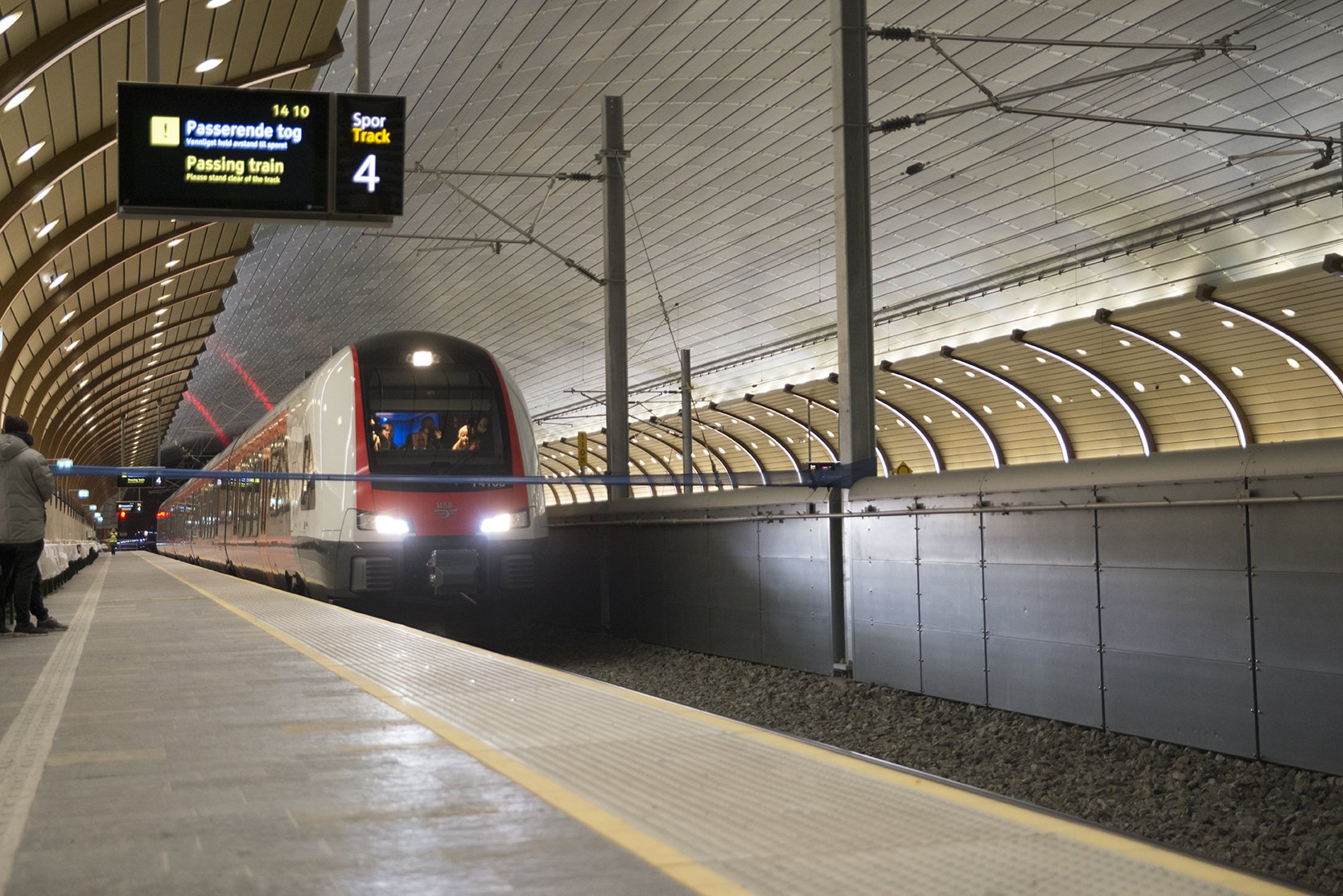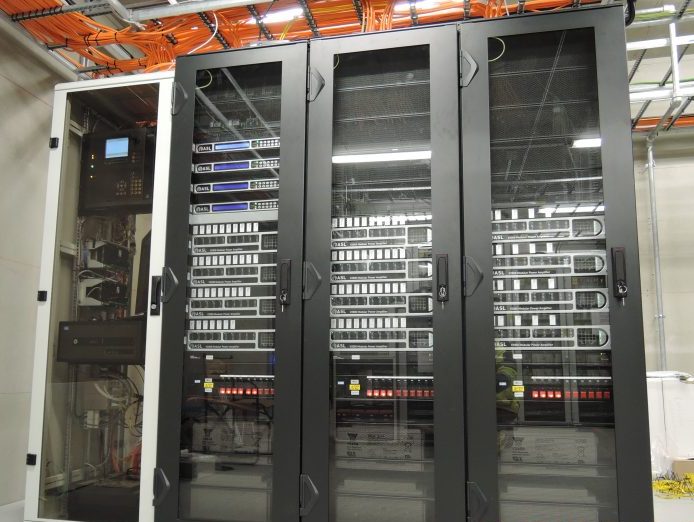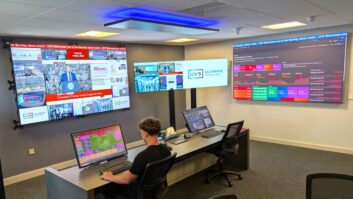
A new railway station, located in a mountain tunnel, has an IP-based PA-VA system that is networked to other stations on the line.
Holmestrand is known as “the city under the mountain”. Almost 90% of its inhabitants live up on the mountain plateau, while the old part of the town, with its idyllic houses and marina, lies at the foot of a steep rockface looking out over a fjord.
The municipality has a new railway station, engineered into the mountainside along a tunnel 12km in length. The project to build the tunnel and the train station began in summer 2010. Blasting of the rock cavern, to 35m wide and 18m high, commenced in December 2011 and concluded in 2014. The station was officially opened in December 2016 by the Norwegian Prime Minister.
The majority of residents use lifts to access the spectacular new station hall, which measures 870m long, 30m wide and 12m high. It houses a platform on each side for northbound and southbound traffic, and a new double-track line that runs from Holm to Nykirke, with ‘through-tracks’ for high-speed trains travelling at up to 250km/h.
Engaged by Jernbaneverket (Bane NOR – the Norwegian government railways services agency), Application Solutions (Safety and Security) Ltd (ASL) partnered with Innotronic of Scandinavia and SAC Sweden to deliver a comprehensive EN54 certified public address and voice alarm (PA-VA) system at Holmestrand station.
First for VIPEDIA
While ASL has delivered long-line PA-VA systems to more than 300 stations for Bane NOR, Holmestrand station was the first to utilise ASL’s new VIPEDIA range of products. The VIPEDIA range – which includes audio routers, amplifiers and microphones – is certified to EN54-16 and internationally recognised by the Loss Prevention Certification Board.
The solution at Holmestrand is designed around ASL’s VIPEDIA-12 range of hardware. It provides audio routing between 12 analogue inputs and 12 analogue outputs. The VIPEDIA-12 also includes provision for 64 internally stored digital voice announcement messages and hosts ASL’s VIPA long-line public address software.
At Holmestrand, four VIPEDIA-12 audio routers were locally linked to provide routing from any or all of their inputs to a total of 48 zone outputs, all configured via an Ethernet network.
Two ASL EMS10 Emergency Microphone Stations, housed in lockable wall mounting boxes, provide live and pre-recorded message broadcast. Each feature graphic LCD displays together with ‘Power’, ‘Voice Alarm’, ‘System Fault’, ‘Fault’ and ‘Speak Now’ indicators.
The EMS10 Emergency Microphone Stations implement router hardware bypass to ensure continued all-call microphone operation in the event of matrix digital signal processor or central processing unit failure.
Two additional ASL MPS10 paging microphones can broadcast live, store-forward and recorded messages into user-selected zones in addition to providing EN54-compliant emergency functions and mandatory indicators and controls.
Amplifiers
ASL’s V2000 amplifiers provide high-quality transformer-less audio output, configurable in software from 25W to 500W output per module. Seven were installed per V2000 chassis at Holmestrand station, to provide a total of almost 19,000W of 100V output.
Integrated EN54-4 certified battery chargers in the V2000’s charger battery packs – each with enough capacity for a fully loaded V2000 amplifier as well as one VIPEDIA-12 and peripherals – avoid the need for external chargers. Installed ASL LSZDC amplifier cards provide amplifier health monitoring, standby switchover, loudspeaker line earth leakage monitoring and loudspeaker line ‘end of line’ monitoring.
Configured using a user-friendly graphic software interface, the V2000’s standby modes and low quiescent power requirements provide improved environmental performance, ensuring the Holmestrand PA-VA system minimises its carbon footprint too.

Integral to the operation of the PA-VA system at Holmestrand station and across Bane NOR’s network of train stations is ASL’s VIPA software suite. Running on ASL hardware at every station where ASL’s iPAM one-box PA solution is installed, and now also on VIPEDIA installed hardware, VIPA provides audio over IP, routing control and fault reporting capability between Bane NOR’s Control Centre and all of the remote railway stations, including Holmestrand.
VIPA, one of the first audio-over-IP systems developed specifically to meet the requirements of long-line public address systems, delivers live broadcasts using UDP multicast over IP. Multicast broadcasts offer the benefit over unicast broadcasts of requiring just single audio streams to deliver audio to however many stations Bane NOR’s Control Centre chooses, reducing the required bandwidth.
Remote locations
VIPA also has the ability to stream digital voice announcement messages from the Control Centre or to trigger them at remote locations on the station network, subject to bandwidth availability. Additionally, live audio broadcasts can be transmitted in high or low bandwidth modes. This can be particularly useful where network bandwidth is more restricted, which has been the case in some legacy and brownfield installations on Bane NOR’s network.
The software also provides detailed fault monitoring of remote trains stations via IP, as well as providing a software API for interfacing with third-party train timetabling/messaging systems.
VIPA has also been interfaced with a custom software module, which allows Bane NOR to trigger messages on legacy PA systems at other stations on the network – thanks to a module that uses DTMF tones to control remote stations. Developed by in-house software teams at ASL, VIPA’s modular architecture and software development kit allows integration with other third-party PA systems, should it be required.
The successful introduction of ASL’s new VIPEDIA range of products at Holmestrand is already being replicated in other stations across Bane NOR’s network; installations are taking place at Oslo Airport’s Gardemoen station.
Roy Strand, department manager for Bane NOR, comments: “ASL has been a key supplier to Bane NOR for around 10 years, delivering over 300 stations using the Vipedia and iPAM ranges of PA-VA equipment. Their customer-focused approach to design, manufacture and maintenance ensures we continue to work together”.
Sousan Azimrayat, commercial director at ASL, comments: “It was a fantastic experience to be told by the Bane NOR project manager that the ASL voice alarm system was the first of all the telecommunication systems to be fully commissioned and working and the system sounds good.”
Main picture: Anne Mette Storvik, Bane NOR
www.asl-control.co.uk
www.banenor.no
www.innotronic.dk
www.sacnordic.com







